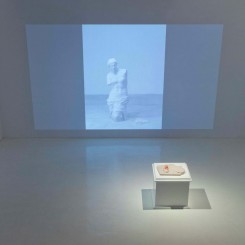Cao Hui solo exhibition.
PIFO Gallery (B-11, 798 Art Area,No.2 Jiuxianqiao Rd, Chaoyang District, Beijing, China. Nov 24 – Dec 28, 2012.
Cao Hui’s current solo exhibition is a success in the best Svankmajerian mode, to the extent that one wonders whether the work of the great Czech film maker is an influence. Jan Svankmajer’s (b.1934) coarse, surrealist animations — particularly those created using stop-motion techniques — bring to life stories, political critique and observations of the human condition in a manner as incisive as it is textured and imaginatively compelling. Objects and living things are set in motion in varying relation to what is real or ordinary, extracting from them unforeseen absurdity, eeriness, charm or truth.
Cao Hui in the past has created sculptures of chairs and clothing out of resin resembling skin and innards, which hang and bulge out from them in grotesque fashion. Most recently, he has spent almost three years completing the partite works that compose his current solo exhibition: “OH, NO,” “Do Not Forget Me” and “If I Were,” turning his attention from ordinary objects to classic masterpieces by Michelangelo. These he has replicated and newly invested with lifelike insides made visible by cutting each sculpture into even slices or chunks. They are hung about the walls of the gallery in an absurdly literal and methodical butchering of the classical form. The sculptures appear, too, in animation videos on display. “OH, NO” sees an imperial head being made as if to shake by the sliding of its segments from left to right to a soundtrack of a deep, deadpan voice repeating the two words. On the facing wall, Aphrodite is gradually built up and down, slice by slice, to strains of classical music. In the corner, an outsized head of David stands dismantled to the neck, with chunks of the face and cranium fanning out around it on the floor.
This is bizarre spectacle will no doubt keep many at bay. The artist says little about his work, but like the earlier “biological” sculptures, these shouldn’t be taken too seriously. One is led to favor a note of fun over the potential for reading into these works as an embodied critique of classical sculpture (no pun intended). Here, after all, is Aphrodite laid out like sliced bread, with a lifelike digestive system and a form wholly indigestible for the ideals of classical beauty. Like Svankmajer, Cao shows an ability to take the familiar and hurl it into different visual and imaginative realms that hover in the uncanny territory between logic and aesthetics — in this case, relative to the human body as real, or Renaissance. Classical anatomy of a wholly different kind.

